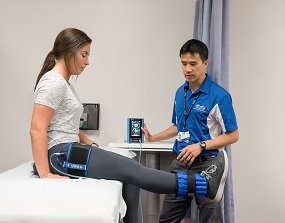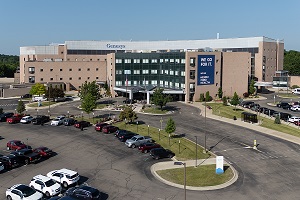Rehabbing Muscle with BFR

DETROIT – In physical therapy it’s known simply as BFR, a popular rehab therapy that uses a blood pressure cuff-like device to trick the body into strengthening muscle without using heavy weights.
BFR stands for blood flow restriction, and it’s among the myriad of services available to patients and athletes at the new William Clay Ford Center for Athletic Medicine.
Originally developed in the 1960s in Japan, BFR is used today in pro sports training programs as well as in the military to help U.S. soldiers recover from injury on the battlefield.
“Blood flow restriction creates an environment where you can actually get stronger using a lower weight,” says Derek Chan, a Henry Ford sports certified specialist in sports physical therapy.
Chan says BFR is used in conjunction with other physical therapy treatment techniques to help athletes recover from injury such as an ACL tear. It’s also being tested for reducing muscle atrophy in patients who are hospitalized in the intensive care unit and bedridden because of serious illness.
“We know from research that it takes about six to 10 weeks to demonstrate measurable changes,” Chan says. “But after one session, I’ve had patients tell me ‘wow, I feel different already.’”
 BFR is performed during low-intensity exercises in early-stage rehab under the watchful eye of a physical therapist. It works by compressing blood vessels in the muscles being rehabbed – typically the arm or leg – with a specially-designed device that resembles a blood pressure cuff or tourniquet. The device fits snugly around the arm or leg in close proximity to the muscle being worked.
BFR is performed during low-intensity exercises in early-stage rehab under the watchful eye of a physical therapist. It works by compressing blood vessels in the muscles being rehabbed – typically the arm or leg – with a specially-designed device that resembles a blood pressure cuff or tourniquet. The device fits snugly around the arm or leg in close proximity to the muscle being worked.
During exercise, the blood pools in the muscles being worked – it’s been described as like filling a water balloon – leading to an increase in the body’s lactate acid. “It feels like your muscles are engorged,” Chan says.
He likens it to doing bicep curls at the gym. You typically use 30 pounds for a bicep curl. With BFR, you could use five pounds to achieve a similar effect. “Your muscles are really pumped up even after that light weight. That’s what it feels like after BFR,” Chan says. “It tricks the muscle into thinking it’s active.”
BFR, Chan says, is beneficial for athletes trying to speed up their recovery process.
Because BFR involves compressing blood flow, Chan recommends it only be performed by a health care professional. “When we use BFR, we use it as a very measured level,” he says. “This is not something to be done by the do-it-yourselfer.”
###
MEDIA CONTACT: David Olejarz / David.Olejarz@hfhs.org / 313.874.4094
.svg?iar=0&hash=F6049510E33E4E6D8196C26CCC0A64A4)

/hfh-logo-main--white.svg?iar=0&hash=ED491CBFADFB7670FAE94559C98D7798)







